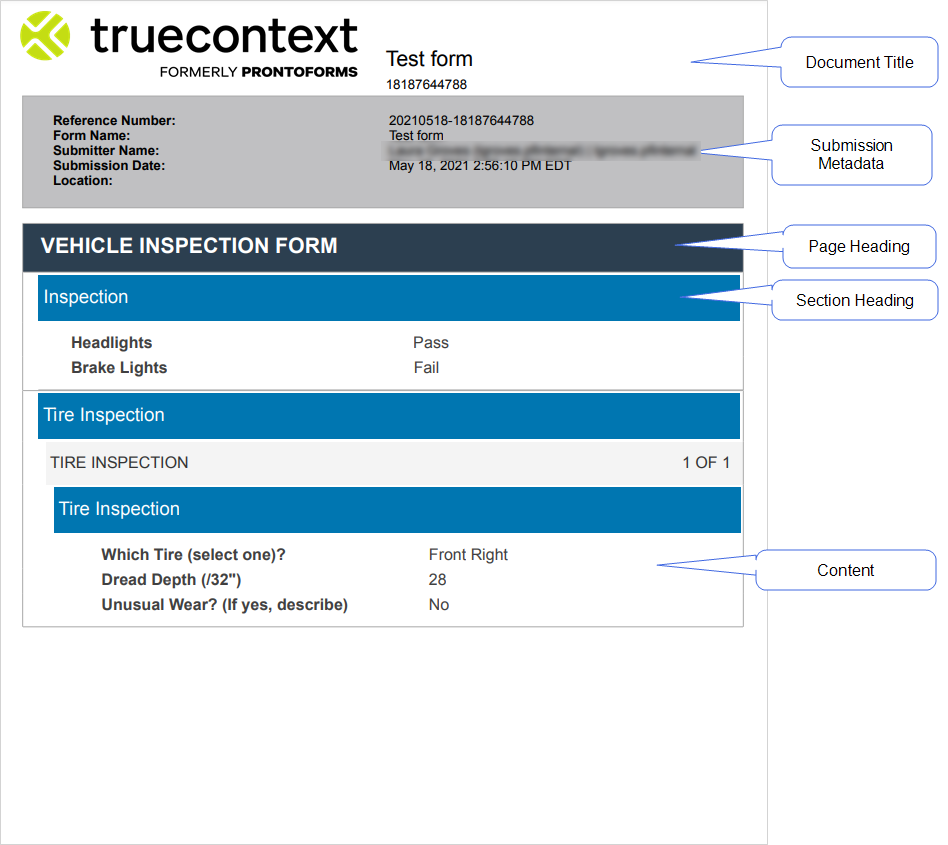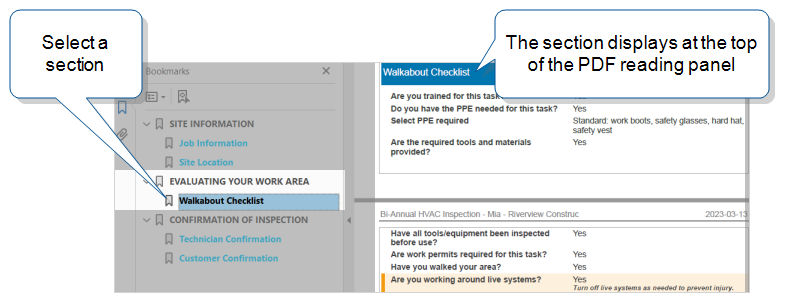Introduction to TrueContext Documents
A Document is a type of output that contains the data collected in the field. You can set up readable (visual) Documents, such as PDF, Excel, and Word. You can also set up structured data Documents—such as XML, JSON, and CSV—to integrate with your back-office systems. This topic describes the types of Documents that are available and includes links you can follow to learn more about each type.
Available on all tiers, with more options on the Advanced and Enterprise tiers:
Contents
How a Document works
Note:You can’t attach documents to a Repeatable Destination![]() A Repeatable Destination is a TrueContext Data Destination that sends data from a Repeatable Section to a field-based, third-party system.. This prevents duplication of the same document across multiple records.
A Repeatable Destination is a TrueContext Data Destination that sends data from a Repeatable Section to a field-based, third-party system.. This prevents duplication of the same document across multiple records.
Multiple Documents Per Form
Forms can have multiple output documents, each with a different appearance and format. You can choose what to include in each document as well. This makes it possible to generate internal-use and customer-facing documents from a single form submission.
Share Documents Across Forms
Create and customize one document, then use it with multiple forms.
Multi-Language Documents
Available as an add-on to the Advanced and Enterprise tiers:
A Multi-Language Document is an output document that's linked to a Multi-Language Form![]() A Multi-Language Form is a form that’s set up with different translations so that field users can choose their preferred language. Translated content includes page and section names, question text, help text, and other form content.. You can generate this document in any language configured in the form, regardless of whether the language is set as Active for form completion. Use Multi-Language Documents to produce files for all your field users, systems, or customers in their preferred languages—for example, generate English and Spanish versions of the same submission for different audiences.
A Multi-Language Form is a form that’s set up with different translations so that field users can choose their preferred language. Translated content includes page and section names, question text, help text, and other form content.. You can generate this document in any language configured in the form, regardless of whether the language is set as Active for form completion. Use Multi-Language Documents to produce files for all your field users, systems, or customers in their preferred languages—for example, generate English and Spanish versions of the same submission for different audiences.
The following document types support multiple languages:
-
Standard PDF, Microsoft Word, and HTML
-
XML and JSON
Info:The topic Multi-Language Document Setup Options describes when documents require translations.
Document Types
Visual and Printed Documents
-
PDF, Word, and HTML Documents: Choose data from your form to include in a PDF, Word, or HTML Document. The following example shows the content you can include in a Document.
-
Excel Document: Choose data from your form to include in a custom-formatted Excel document.
Structured Data Formats
- XML: Use data from your form to create an XML file with a customizable structure.
- JSON: Use data from your form to create a JSON file.
- CSV: Choose the data to include in a customizable CSV file.
Note:If ![]() A Data Destination specifies where to send data from a submitted form. You can use Data Destinations to automate data sharing and storage, routing data to a specific service (such as email or cloud storage) in several different formats.. The document shows translated form content based on the form’s translation file. The key names and question Unique IDs don’t change. For your integrations, map to the question Unique ID
A Data Destination specifies where to send data from a submitted form. You can use Data Destinations to automate data sharing and storage, routing data to a specific service (such as email or cloud storage) in several different formats.. The document shows translated form content based on the form’s translation file. The key names and question Unique IDs don’t change. For your integrations, map to the question Unique ID![]() A Unique ID refers to the specific identifier of a question, form page, form section, or Data Destination. Unique IDs are used as reference points when pulling data for conditional logic, Analytics projects, Data Destinations, and Documents., which doesn’t change, and not the question text.
A Unique ID refers to the specific identifier of a question, form page, form section, or Data Destination. Unique IDs are used as reference points when pulling data for conditional logic, Analytics projects, Data Destinations, and Documents., which doesn’t change, and not the question text.
Custom Document Layouts
Available on the Advanced and Enterprise tiers:
Our Standard layouts are designed to work with any form, and they support our Multi-Language Feature. Standard layouts offer a variety of formatting options that you can use to tailor your business document or report. When you need even more control over your document layout and structure, use a Custom Layout.
Template-Driven Text Documents
Available on the Advanced and Enterprise tiers:
-
DREL Documents: Use DREL to build a text file.
-
Handlebars Documents: Use the Handlebars templating language to build a text file.
-
FreeMarker Documents: Use the Apache FreeMarker™ templating language to build a text file.
Meetings and Contacts
These document formats are commonly used in mail, calendar, and Customer Relationship Management (CRM) systems.
- Event Invitations: Use data from your form to create an invitation that can be sent by email.
- Business Cards: Use data from your form to create a virtual business card file that can be sent by email.

